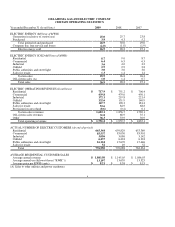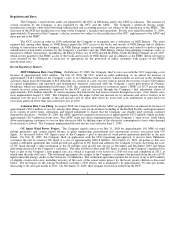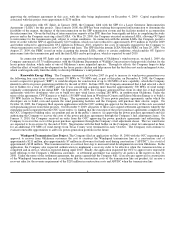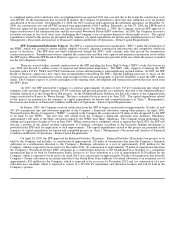OG&E 2009 Annual Report Download - page 18
Download and view the complete annual report
Please find page 18 of the 2009 OG&E annual report below. You can navigate through the pages in the report by either clicking on the pages listed below, or by using the keyword search tool below to find specific information within the annual report.
regarding the reduction of greenhouse gases could result in significant changes to the Company’s operations, significant capital
expenditures by the Company and a significant increase in our cost of conducting business.
On September 22, 2009, the EPA announced the adoption of the first comprehensive national system for reporting emissions
of carbon dioxide and other greenhouse gases produced by major sources in the United States. The new reporting requirements will
apply to suppliers of fossil fuel and industrial chemicals, manufacturers of motor vehicles and engines, as well as large direct emitters
of greenhouse gases with emissions equal to or greater than a threshold of 25,000 metric tons per year, which includes certain
Company facilities. The rule requires the collection of data beginning on January 1, 2010 with the first annual reports due to the EPA
on March 31, 2011. Certain reporting requirements included in the initial proposed rules that may have significantly affected capital
expenditures were not included in the final reporting rule. Additional requirements have been reserved for further review by the EPA
with additional rulemaking possible. The outcome of such review and cost of compliance of any additional requirements is uncertain
at this time.
On December 15, 2009, the EPA published their finding that greenhouse gases contribute to air pollution that may endanger
public health or welfare. Although the endangerment finding is being made in the context of greenhouse gas emissions from new
motor vehicles, the finding is likely to result in other forms of regulation. Numerous petitions are pending at the EPA from various
state and environmental groups seeking regulation of a variety of mobile sources (i.e., trucks, airplanes, ships, boats, equipment, etc.)
and stationary sources. With the endangerment finding issued, the EPA is likely to begin acting on these petitions in 2010.
Additionally, on December 2, 2009 the Center for Biological Diversity announced a petition with the EPA seeking promulgation of a
greenhouse gas National Ambient Air Quality Standard (“NAAQS”).
On September 30, 2009, the EPA proposed two rules related to the control of greenhouse gas emissions. The first proposal,
which is related to the prevention of significant deterioration and Title V tailoring, determines what sources would be affected by
requirements under the Federal Clean Air Act programs for new and modified sources to control emissions of carbon dioxide and
other greenhouse gas emissions. The second proposal addresses the December 2008 prevention of significant deterioration
interpretive memo by the EPA, which declared that carbon dioxide is not covered by the prevention of significant deterioration
provisions of the Federal Clean Air Act. The outcome of these proposals is uncertain at this time.
FINANCE AND CONSTRUCTION
Future Capital Requirements
Capital Requirements
The Company’s primary needs for capital are related to acquiring or constructing new facilities and replacing or expanding
existing facilities in its electric utility business. Other working capital requirements are primarily related to maturing debt, operating
lease obligations, hedging activities, delays in recovering unconditional fuel purchase obligations, fuel clause under and over
recoveries and other general corporate purposes. The Company generally meets its cash needs through a combination of cash
generated from operations, short-term borrowings (through a combination of bank borrowings, commercial paper and borrowings
from OGE Energy) and permanent financings. See “Item 7. Management’s Discussion and Analysis of Financial Condition and
Results of Operations – Liquidity and Capital Requirements” for a discussion of the Company’s capital requirements.
Capital Expenditures
The Company’s estimates of capital expenditures are approximately: 2010 - $500 million, 2011 - $555 million, 2012 - $495
million, 2013 - $425 million, 2014 - $350 million and 2015 - $315 million. These capital expenditures represent the base maintenance
capital expenditures (i.e., capital expenditures to maintain and operate the Company’s business) plus capital expenditures for known
and committed projects (collectively referred to as the “Base Capital Expenditure Plan”). The table below summarizes the capital
expenditures by category:
14
























